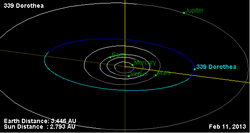Astronomy:339 Dorothea
From HandWiki
Short description: Main-belt asteroid
 Orbital diagram | |
| Discovery | |
|---|---|
| Discovered by | Max Wolf |
| Discovery date | 25 September 1892 |
| Designations | |
| (339) Dorothea | |
| Pronunciation | /dɒəˈθiːə/[1] |
| Named after | Dorothea Klumpke |
| 1892 G | |
| Minor planet category | Main belt (Eos) |
| Orbital characteristics[2] | |
| Epoch 31 July 2016 (JD 2457600.5) | |
| Uncertainty parameter 0 | |
| Observation arc | 123.55 yr (45128 d) |
| |{{{apsis}}}|helion}} | 3.3041 astronomical unit|AU (494.29 Gm) |
| |{{{apsis}}}|helion}} | 2.71937 AU (406.812 Gm) |
| 3.01176 AU (450.553 Gm) | |
| Eccentricity | 0.097082 |
| Orbital period | 5.23 yr (1909.1 d) |
| Mean anomaly | 271.598° |
| Mean motion | 0° 11m 18.852s / day |
| Inclination | 9.9640° |
| Longitude of ascending node | 173.512° |
| 164.360° | |
| Physical characteristics | |
| Dimensions | 38.25±1.6 km |
| Rotation period | 5.974 h (0.2489 d) |
| Geometric albedo | 0.2431±0.021 |
| S (Tholen) K (SMASSII) | |
| Absolute magnitude (H) | 9.24 |
Dorothea (minor planet designation: 339 Dorothea) is a large main belt asteroid that was discovered by German astronomer Max Wolf on 25 September 1892 in Heidelberg.
This is a member of the dynamic Eos family of asteroids that were probably formed as the result of a collisional breakup of a parent body.[3]
This asteroid is named after astronomer Dorothea Klumpke,[4] as is 1040 Klumpkea.
References
- ↑ Noah Webster (1884) A Practical Dictionary of the English Language
- ↑ Yeomans, Donald K., "339 Dorothea", JPL Small-Body Database Browser (NASA Jet Propulsion Laboratory), https://ssd.jpl.nasa.gov/sbdb.cgi?sstr=339, retrieved 11 May 2016.
- ↑ Veeder, G. J. et al. (March 1995), "Eos, Koronis, and Maria family asteroids: Infrared (JHK) photometry", Icarus 114: pp. 186–196, doi:10.1006/icar.1995.1053, Bibcode: 1995Icar..114..186V, http://adsabs.harvard.edu/cgi-bin/nph-data_query?bibcode=1995Icar..114..186V&link_type=EJOURNAL&db_key=AST&high=, retrieved 2013-04-06.
- ↑ Vatican Observatory website
External links
- 339 Dorothea at AstDyS-2, Asteroids—Dynamic Site
- 339 Dorothea at the JPL Small-Body Database
 |

